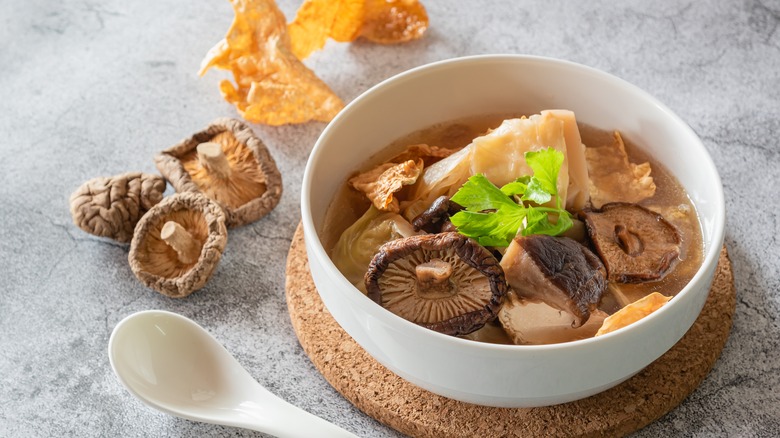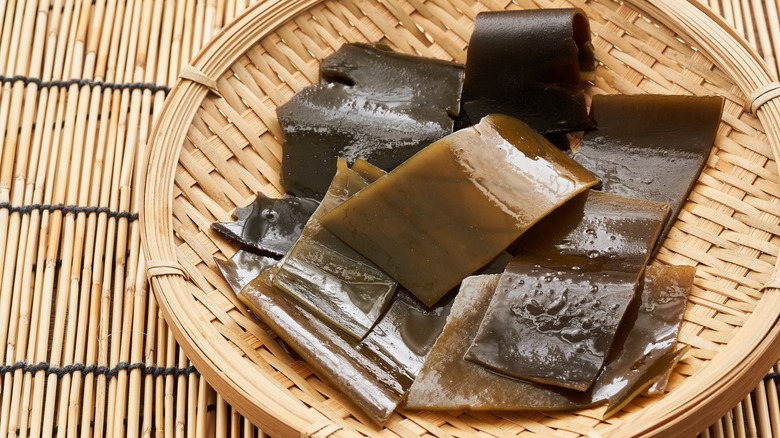The 10 Absolute Best Fish Sauce Substitutes
Fish sauce, made from salted, fermented fish, is a key ingredient in East and Southeast Asia cuisines, where it's been produced since ancient times (the ancient Greeks and Romans, who invented their fish sauce garum independently, were wild about it too). Packed with deep salty and savory (umami) flavors, there are three main types of fish sauce, each having a wide range of traditional uses, from Lao dipping sauces to Korean kimchi. It can also add its signature pungent funk to everything from burgers to tomato sauce, from soups and stir-fries to marinades and raw salads.
In many recipes, fish sauce can be used as a more complex and flavorful substitute for plain salt. But what if you need a substitute for fish sauce? Whether you can't use fish sauce due to an allergy or dietary restriction or you can't get your hands on a bottle, you can try one of the options below. Here are eleven potential fish sauce substitutes, all vegan-friendly except the first on the list.
Anchovies
For several substitutes, look toward the history of fish sauce for inspiration. Fish sauce is believed to have been discovered as an accidental byproduct of anchovy preservation. Ancient fishermen in both Asia and the Mediterranean packed tiny anchovies in salt to keep off bacteria and allowed them to ferment in the sun to preserve them. The briny, fishy liquid that seeped out was fish sauce, and ancient people enjoyed its flavor so much that they began producing it deliberately, saving the fermented paste from the solid fish for other culinary applications. Some modern styles, like Vietnamese fish sauce, are still made in much the same way today.
Considering the origin of the first fish sauces, a tin of small anchovies may be a readily-available substitute if you can't find fish sauce. Just don't confuse anchovies with sardines. Both fish are often canned, but compared to anchovies, sardines are larger, less salty, more savory, and have bigger bones that may need to be removed from a dish.
When substituting, it's suggested to use one anchovy filet per ½ teaspoon of fish sauce. Packed with saline flavor, anchovies are so small that they can be easily blended whole and incorporated into sauces and dressings. Take, for example, the traditional use of anchovies in Caesar salad dressing or some Italian pasta sauces like puttanesca. You can also purchase pre-blended anchovy paste. Drain the tin before mashing the anchovies. Some whole anchovies are packed in olive or other oils, adding flavor to a recipe.
Soy sauce
There's already a long history of using soy sauce as a fish sauce substitute due to dietary restrictions: it's the traditional replacement for fish sauce in the vegan cuisine of Buddhist monks. Soy and fish sauce are like siblings; both descended from ancient dressings made of meat or fish fermented with soybeans, though the ancient predecessor of soy sauce later separated into soybean-only varieties. Soy sauce is more widely available than fish sauce and is commonly sold in non-Asian grocery stores. Those looking to avoid gluten should note that while soy sauce is generally vegan, it's not always gluten-free; some soy sauces are made with a blend of soybean, wheat, or other ingredients.
When a recipe calls for fish sauce, soy sauce can be used in a 1 to 1 ratio, although some recommend adding a splash of vinegar. However, there are numerous varieties of soy sauce, each with specific uses, and soy sauces from different countries can differ greatly. In Chinese cuisine, for example, light soy sauce is the primary soy sauce used for flavor and saltiness in cooking, while dark soy sauce has a less-intense flavor and is added in small amounts to give a rich color to dishes. Using only dark soy sauce in place of light will not yield a satisfactory result. Other soy sauce may be syrupy, sweet from added sugar, or extremely pungent from long fermentation.
Vegan Fish Sauce
To understand what works as a fish sauce alternative, we have to take a look at the chemistry behind fish sauce's signature flavor. When you taste something umami, you're really tasting compounds called glutamates (glutamic acids). Our bodies evolved to find glutamates tasty because they indicate the presence of the protein we need for survival. Many ingredients naturally contain glutamates, but especially large amounts of glutamates are created when proteins break down during fermentation. That's why savory fermented sauces and pastes like soy and fish sauce exist in so many cuisines around the world and why it's possible to capture the essential flavors of fish sauce by fermenting high-protein ingredients other than fish. Our ability to taste glutamates is also enhanced by the presence of nucleotides which are also naturally present in foods such as mushrooms.
Naturally, creative and modern chefs have begun creating vegan fish sauce alternatives with ingredients like shiitake mushrooms and black garlic. Like soy sauce, these substitutes can generally be used in the same proportion as fish sauce. You can find vegan soy sauce online, in health and vegan food stores, or make it yourself. Vegan versions of oyster sauce (a thicker, sweeter Chinese sauce made from fermented shellfish, distinct from fish and soy sauces) are also commercially available.
Salt
Fish sauce is high in sodium, and when people cook with fish sauce, they partly use it for its saltiness. However, salt lacks fish sauce's savory glutamates and its nutritional complexity. Comparing the nutritional value of these two components, fish sauce contains about ⅕ the amount of sodium of table salt per serving and much-higher quantities of various nutrients, especially magnesium, iron, and B vitamins. But you can still use less salt as a fish sauce substitute. It's recommended to use one teaspoon of pure salt as the equivalent of one tablespoon of fish sauce.
When using salt in place of fish sauce, make sure that you have other ingredients in your recipe to supply the added flavor that salt is lacking. Common foods high in glutamates include Parmesan cheese, grape or tomato juices, and cured ham. One especially savory variety of salt with various culinary applications is kala namak, or Indian black salt. Its meaty aroma and flavor come not from glutamates but from natural compounds called sulfides, also present in onions and cooked eggs, making black salt a popular ingredient in vegan recipes. It should be noted that some salts are better suited for cooking and others for finishing an already-cooked plate. The grain size of your salt will affect how salty the final dish tastes; for example, you would need a larger volume of sea salt than table salt to get the same flavor in cooking because sea salt grains are typically larger than table salt grains.
Liquid Aminos
Fermentation is only one way to break down proteins and create those delicious glutamates. A chemical process called hydrolyzation is another, wherein soybeans are treated with an acidic solution to break down the proteins, and a product called liquid aminos is made. The resulting product is rich in amino acids (the building blocks of proteins), hence its name, but lower in sodium, which liquid aminos inventor Paul Bragg believed was harmful to health when he first developed the product in 1912. Some liquid aminos available today are made from coconut sap. Despite the name, these coconut-derived products will be even closer to a fish sauce substitute than Bragg's because they are fermented, not hydrolyzed.
Liquid aminos look and taste similar to soy sauce but are much lower in sodium than soy sauce (especially coconut aminos) and are reliably gluten-free. Liquid aminos are not commonly sold in Asian grocery stores, so they may be available even if you lack access to Asian food products. You can use liquid aminos in the same proportions as soy or fish sauce, but you may wish to add additional salt due to the lower sodium content.e
Maggi
This Swiss Nestlé product is popular around the world, with nine different blends of Maggi seasoning transcending culinary borders to be available in different regions depending on local tastes. Maggi's base is wheat that has been hydrolyzed, just like the soybeans used to make liquid aminos, a process invented by entrepreneur Julius Maggi in 1886. Although the hydrolyzation process reduces the amount of gluten in wheat products, research is inconclusive as to whether such products are suitable for those with gluten intolerance.
Maggi is often added directly to food to season it during a meal, but you can also cook with it just as you would soy or fish sauce, using the same proportions. When substituting, be sure to taste the Maggi you are using first to see how its flavor may affect the outcome of your recipe, as the exact blend of ingredients in a bottle of Maggi varies depending on which country's version you're using. For example, consumers in the Philippines can purchase Maggi Savor, which has a strong garlic flavor, and Savor Calamansi, flavored with calamansi citrus fruit. The Maggi typically sold in the USA does not contain added MSG, unlike most other Maggi blends. The Maggi brand also makes many other popular products, including bouillon cubes and instant noodles.
Steak Sauce
Steak sauce like Worcestershire and A1 contains many of the same compounds as soy and fish sauces. Some are even made with glutamate-rich mushrooms or anchovies, plus spices, sugar, and fruit. It may not be the closest to fish sauce on the list in terms of taste, but steak sauce can still provide a delicious and flavor-packed result.
When substituting, be aware that steak sauce has a powerful and complex flavor that goes beyond salty and savory, which will affect the outcome of your recipe. Steak sauce is likely not the best choice of substitute in preparations where the flavor of fish sauce is meant to be prominent and complimented by just a few other ingredients, as in Southeast Asian dipping sauces. Try it in cooked sauces and stir-fries instead. Most steak sauces also contain vinegar, so you may wish to eliminate or reduce the number of acidic ingredients when cooking with it. Vegan steak sauce recipes use soy sauce as the base plus additional flavoring ingredients.
Seaweed
By some reports, MSG (monosodium glutamate), one of the glutamic acids that provide the key to umami flavor, was first identified in kombu, a type of kelp. Many other seaweeds are also naturally rich in glutamates, with salty marine flavors that recall those of fish sauce. Edible seaweeds are incredibly diverse, with over 70 edible species known from Hawai'i alone. And the uses of seaweeds are similarly myriad; some think they ought to be referred to in English as "sea vegetables" to better represent their culinary utility.
Nori, the thin dried sheets of seaweed used to wrap Japanese sushi, is probably the easiest seaweed to find outside Asian grocery stores. Tougher seaweeds like kombu are typically boiled to flavor broth or soup, but more delicate seaweeds like nori and wakame can be dried and powdered or chopped for salads. Because of the diversity in flavor, texture, and consistency, deciding which type of seaweed will work best for a recipe requires some consideration. Another thing to keep in mind is that seaweed naturally contains some sodium from seawater. When using seaweed powder as a substitute for the fish sauce, you may wish to add a small amount of vinegar, similar to the use of soy sauce.
Bouillon
Whether it's mushroom-, vegetable- or meat-based, bouillon contains glutamic acids and can easily provide the richness of fish sauce to many dishes. In West African countries like Ghana and Nigeria, where umami-fermented pastes and sauces are traditionally produced from beans and seeds (as in Asia), many cooks now use Maggi bouillon cubes as an everyday sub for these traditional ferments.
Some bouillon is high in sodium, but reduced or sodium-free versions are also available. Bouillon cubes are typically added to soups or sauces, but these have only been commercially available since the early 20th century; the original form of bouillon was granular chicken powder. Powdered bouillon is more versatile as a cooking ingredient and can be used in smaller amounts to season sauces and even raw salads. When cooking with bouillon cubes, the exact proportion of water to cubes varies depending on the brand of bouillon. One cup to one cube works for some brands, but for Maggi and Knorr bouillon, the ratio is two cups of liquid to one cube. Check the label to be sure of the correct ratio.
Asafetida (Hing)
A staple spice in the Indian subcontinent, where it's known as hing, among other names, asafetida is the dried resin of a plant related to fennel and celery. Raw asafetida has a strong, unpleasant smell, but when cooked, this mellows into a pungent oniony richness. In South Asia, asafetida is typically used to impart savoriness to vegetarian dishes, especially those that do not contain allium (garlic and onions). Its flavor comes from compounds called sulfides, also found in cooked onions, the aforementioned Indian black salt, and some fermented, glutamate-rich foods like black garlic.
You can buy asafetida online or at South Asian grocery stores and some health food stores. It's most commonly sold as a powder, often with a fixative added to prevent clumping, but you can also buy chunks of the resin, which must be grated finely with a microplane, steamed, or dipped in hot water to release the flavor. Asafetida is not salty on its own, so any use of it in place of fish sauce should also include ample salt. A very small amount is all that's needed for a dish (most culinary professionals will suggest a pinch of asafetida per 250 grams per ½ pound of the main ingredient). Since asafetida needs to be cooked, it should not be used in raw salads or dipping sauces.
MSG
MSG (monosodium glutamate) is the star chemical component of fish sauce and of many of the foods on this list. If all else fails, powdered MSG can directly add a fish sauce-like meaty richness to your cooking. MSG is a common cooking ingredient in Asia, but rumors have long marred its reputation in the West; the avoidance of MSG is why American Maggi doesn't contain it, and some products are specifically advertised as MSG-free.
Don't believe the biggest misconceptions about MSG, such as the suggestion that it is a harmful artificial chemical that induces headaches and other health problems; it's just a type of salt, and any salt is bad for us in too-large quantities. Far from being synthetic, MSG occurs naturally in many familiar foods across every category of ingredients. The research of Kikunae Ikeda, the Japanese chemist who discovered MSG in kelp, was inspired by flavor similarities Ikeda noticed between his favorite Western and Japanese foods despite their lack of shared ingredients. We now know that Ikeda was tasting MSG and other glutamates. The shared quality Ikeda perceived in these foods was the savory flavor that he later dubbed umami, which can be translated as "deliciousness."
As it's most commonly available in powdered form, MSG is as versatile as bouillon powder and can be used in various ways. Be aware that it is still salty in addition to being savory, though not as salty as table salt (sodium chloride). Recipes typically use more table salt than MSG.











